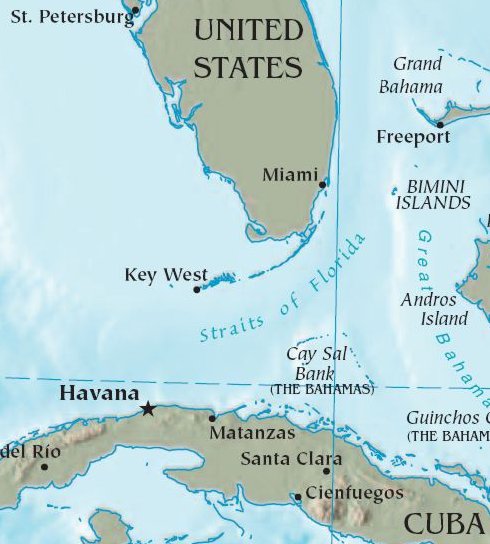
亡命キューバ人
Cuban exodus, Exilio cubano

☆キュー バ・エクソダス(Cuban exodus)(=亡命キューバ人、キューバ難民、キューバ脱出民)とは、1959年のキューバ革命後にキューバ人がキューバ島から大量に移住したことである。政治的抑圧やキューバでの生活への幻滅から、 キューバ社会における様々な社会的立場の数百万人のキューバ人が様々な移住の波の中で移住した。
| The
Cuban exodus is the mass emigration of Cubans from the island of Cuba
after the Cuban Revolution of 1959. Throughout the exodus, millions of
Cubans from diverse social positions within Cuban society emigrated
within various emigration waves, due to political repression and
disillusionment with life in Cuba.[1][2][3] The first wave of emigration occurred directly after the revolution, followed by the Freedom Flights from 1965 to 1973. This was followed by the 1980 Mariel boatlift and after 1994 the flight of balseros emigrating by raft. During the Cuban exile many refugees were granted special legal status by the US government, but these privileges began to be slowly removed in the 2010s by then-president Barack Obama.[4] The emigrants in the exodus known as "Cuban exiles" have come from various backgrounds in Cuban society, often reflected in the wave of emigration they participated in. Exiles have constructed Cuban communities that continue to preserve Cuban culture abroad, as well as garnering political influence outside Cuba.[5] The majority of the 1,172,899 current Cuban exiles living in the United States live in Florida (917,033 in 2014), mainly in Miami-Dade County, where more than a third of the population is Cuban or of Cuban descent. Other exiles have relocated to form substantial Cuban communities in New York City (16,416), Louisville, KY (6,662), Houston, TX (6,233), Los Angeles (6,056), Union City, NJ (4,970) and others.[6] |
キューバ・エクソダス(Cuban
exodus)とは、1959年のキューバ革命後にキューバ人がキューバ島から大量に移住したことである。政治的抑圧やキューバでの生活への幻滅から、
キューバ社会における様々な社会的立場の数百万人のキューバ人が様々な移住の波の中で移住した[1][2][3]。 最初の移民の波は革命直後に起こり、1965年から1973年までのフリーダムフライトがそれに続いた。その後、1980年のマリエル号によるボートリフ ト、1994年以降のバルセロスのいかだによる移民が続いた。キューバ亡命の間、多くの難民はアメリカ政府から特別な法的地位を与えられていたが、 2010年代に入り、当時のバラク・オバマ大統領によってこの特権は徐々に撤廃され始めた[4]。 「キューバ人亡命者」として知られる亡命者たちは、キューバ社会の様々な背景を持ち、しばしば彼らが参加した移住の波に反映されている。亡命者たちは、 キューバ国外にキューバ文化を守り続けるキューバ人コミュニティを構築し、キューバ国外に政治的影響力を及ぼしている[5]。現在アメリカに住む 1,172,899人のキューバ人亡命者の大半はフロリダ州に住んでおり(2014年には917,033人)、主に人口の3分の1以上がキューバ人または キューバ系であるマイアミ・デイド郡に住んでいる。その他の亡命者は、ニューヨーク市(16,416人)、ケンタッキー州ルイビル(6,662人)、テキ サス州ヒューストン(6,233人)、ロサンゼルス(6,056人)、ニュージャージー州ユニオンシティ(4,970人)などに移転し、実質的なキューバ 人コミュニティを形成している[6]。 |
| History Golden exile and Bay of Pigs Invasion Main article: Golden exile Further information: Aftermath of the Cuban Revolution and Bay of Pigs Invasion Before the post-revolution exile around 50,000 Cuban Americans already resided in the United States. Immediately after the 1959 Cuban Revolution around 200,000 Cubans came to South Florida. Of these immigrants the initial wave were mostly collaborators in the recently toppled Batista regime, of the middle or upper class, and of European descent; subsequent waves were formed from Cubans of many different political opinions and backgrounds who opposed the increasingly authoritarian nature of Castro's rule. Many immigrants believed their exile was temporary since Fidel Castro would soon be toppled. Travel between the United States and Cuba was not heavily restricted even in the wake of the recent revolution. In 1960 Dwight D. Eisenhower established the Cuban Refugee Emergency Center which offered public services to Cuban emigrants. Many immigration restrictions were specifically waived for Cubans entering the United States.[4] A few of these original Cuban exiles were involved in the 1961 Bay of Pigs Invasion which failed to topple Fidel Castro. After the Cuban Missile Crisis of 1962 the Cuban government would restrict air traffic to the island, ending the first major wave of emigration.[4] Operation Peter Pan Main article: Operation Peter Pan To destabilize the communist government, the CIA and Cuban dissidents began warning of a project by the Castroist government to remove the parents' custody of their children to indoctrinate them. Between November 1960 and October 1962, over 14,000 children were sent to the U.S. by their parents in Operation Peter Pan. These children were taken under the care of the Catholic Church and placed in foster homes throughout the U.S. until they could be reunited with their parents. Their parents sent them into the U.S. in order to keep them from communist indoctrination, with many boys being sent to avoid getting drafted into the Cuban armed forces, and girls being put into the greatly politized Alphabetization Campaign.[7] Camarioca boatlift On 28 September 1965, Fidel Castro announced that Cubans wishing to emigrate could do so beginning 10 October from the Cuban port of Camarioca. The administration of U.S. President Johnson tried to control the numbers it would admit to the U.S. and set some parameters for their qualifications, preferring those claiming political persecution and those with family members in the U.S. In negotiations with the Cuban government it set a target of 3,000 to 4,000 people to be transported by air. Despite those diplomatic discussions, Cuban Americans brought small leisure boats from the United States to Camarioca. In the resulting Camarioca boatlift, about 160 boats transported about 5,000 refugees to Key West for immigration processing by U.S. officials. The Johnson administration made only modest efforts to enforce restrictions on this boat traffic. Castro closed the port with little notice on 15 November, stranding thousands. On 6 November, the Cuban and U.S. governments agreed on the details on an emigration airlift based on family reunification and without reference to those the U.S. characterized as political prisoners and whom the Cubans termed counter-revolutionaries. To deal with the crowds at Camarioca, the U.S. added a maritime component to the airborne evacuation. Both forms of transport started operating on 1 December.[8][9] Freedom Flights Main article: Freedom Flights From December 1965 to early 1973, under the Johnson and Nixon administrations, twice daily "Freedom Flights" (Vuelos de la Libertad) transported émigrés from Varadero Beach to Miami. The longest airlift of political refugees,[citation needed] it transported 265,297 Cubans to the United States with the help of religious and volunteer agencies. Flights were limited to immediate relatives and Cubans already in the United States with a waiting period anywhere from one to two years.[10] Many who came through Camarioca and the Freedom Flights were much more racially diverse, of lower economic standing, and of more women compared to earlier emigration waves. This is mainly due to Castro's restriction not allowing skilled laborers to leave the country.[4] Rapprochement with Cuba Main article: El Diálogo See also: Antonio Maceo Brigade During the Carter administration various actions were taken to better relations between the United States and Cuba. In 1978 the first commercial flight in sixteen years would fly from Miami to Havana. The Cuban government would also allow the visit the Antonio Maceo Brigade, the first visit of Cuban exiles to the island. Many Cuban exile organizations would protest the warming of relations with Cuba while some other organizations supported increased diplomacy.[11] Discreet discussions between the United States and Cuba resulted in an agreement to release thousands of political prisoners in August 1978. At the time of the release Jimmy Carter did not want to publicly acknowledge his role in the negotiations. The Cuban government decided to open negotiations with Cuban exiles to better public relations. Originally many Cuban exiles debated the dialogue's usefulness some were satisfied with the invitation while others doubted the sincerity of the negotiations believing it to be a publicity stunt. The Cuban government would eventually state that no prisoners would be released until negotiations took place. Eventually the Comite de los 75 (Committee of 75) would be formed of prominent Cuban exiles and led by Bernardo Benes, they would be the official negotiators with the Cuban government.[12] Mariel boatlift Main article: Mariel boatlift Cuban refugees arriving in crowded boats during the Mariel boatlift crisis 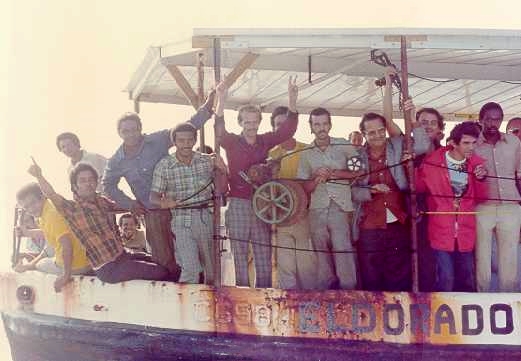 Between 26 April and 1 October 1980, during the Carter administration, probably one of the most significant waves of exiles occurred during what became known as the Mariel Boatlift. The mass boatlift occurred after a number of Cubans drove a bus through the gates of the Havana Peruvian Embassy and requested asylum. One embassy guard died as a result of friendly fire when another guard machine gunned the incoming bus and hit the first one accidentally. When the Peruvian ambassador refused to return the exiled citizens to the authorities, Castro removed the Cuban guards from the embassy, basically opening the door to the 4,000 plus asylum seekers that came into the embassy within the next few days. Reacting to this sudden exodus, Castro stated, "Anyone who wants to leave Cuba can do so" and declared that those who were leaving the country were "escoria" (scum). This resulted in an even larger exodus through the port of Mariel, where an improvised flotilla of Cuban exiles from Miami in small pleasure boats and commercial shrimping vessels brought Cuban citizens who wished to leave the island. Within weeks, 125,000 Cubans reached the United States despite Coast Guard attempts to prevent boats from leaving U.S. waters for Cuba. As the exodus became international news and an embarrassment for the Cuban government, Castro emptied his hospitals and had prison inmates rounded up as "social undesirables",[13][14] and included them among the other refugees. The Cuban Communist Party staged meetings at the homes of those known to be leaving the country.[according to whom?] People were intimidated by these "repudiation meetings" (mitines de repudio), where the participants screamed obscenities and defiled the facades of the homes, throwing eggs and garbage, for hours. Labeled as "traitors to the revolution," those who declared their wish to leave became the targeted victims of the attacks, their rationing cards were taken from them, their jobs were terminated, or they were expelled from schools or universities. Towards the end of the crisis, the repudiation meetings were ended. The scale of the exodus created political difficulties for the Cuban government, and an agreement was reached to end the boatlift after several months. Out of more than 125,000 refugees, a number from as low as 7,500 to as high as 40,000 were believed to have criminal records in Cuba, though many of their crimes would not qualify as crimes under U.S. law. Some 1,774 of the refugees were classified as serious or violent criminals under U.S. law and denied citizenship on that basis. The majority of refugees were young adult males, 20 to 34 years of age, from the working class: skilled craftsmen, semi-skilled tradesmen, and unskilled laborers. In response the aftermath of the Mariel Boatlift, the City of Miami formed the East Little Havana Task Force in 1983.[15] Task Force members were appointed by the Miami City Commission [16] and it was chaired by urban planner and Cuban community leader Jesús Permuy.[17] It was tasked with studying the social and economic effects of the boatlift, particularly in Little Havana, which was an epicenter of the migration. The Task Force adjourned a year later and submitted its findings and official recommendations, called The East Little Havana Redevelopment Plan, to the Miami City Commission and Mayor's Office in 1984.[17] Also in 1984, the United States and Cuba negotiated an agreement to resume normal immigration and to return to Cuba those persons who had arrived during the boatlift who were "excludable" under U.S. law. Many members of the Mariel boatlift were met with suspicion by the Cuban American community already living in the United States. One reason for this was the LGBTQ associations with the exile movement were met with hostility by the portion of the American public that was anti-LGBTQ and they worried that it would worsen their position in the United States.[18] Along similar reasoning, there was concern about the alleged criminal nature of the so-called Marielitos, because of Cuba's dispersion of social undesirables into the exile population.[19] Balseros 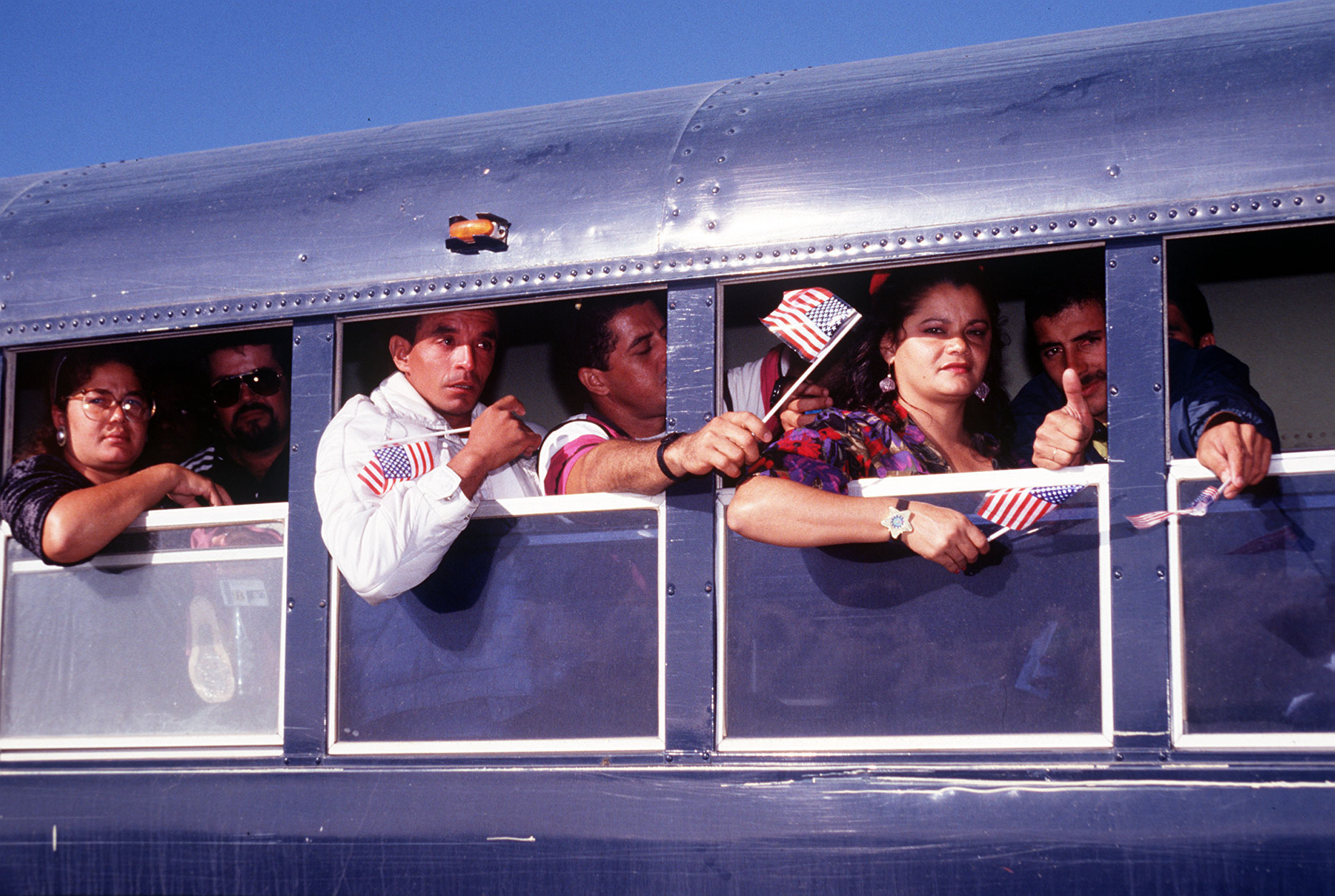 Cuban refugees leaving Guantanamo Bay naval base in the aftermath of the Cuban rafter crisis. Main article: Balseros (rafters) Further information: 1994 Cuban rafter crisis and Wet feet, dry feet policy During the past years, exile waves have consisted of balseros, who travel in homemade rafts. On 18 August 1994, U.S. Attorney General Janet Reno said in a press release:[20] To divert the Cuban people from seeking democratic change, the government of Cuba has resorted to an unconscionable tactic of letting people risk their lives by leaving in flimsy vessels through the treacherous waters of the Florida Straits. Many people have lost their lives in such crossings. We urge the people of Cuba to remain home and not to fall for this callous maneuver. I want to work with all concerned including the Cuban American community to make sure the message goes out to Cubans that putting a boat or raft to sea means putting life and limb at risk... To prevent this from happening again, the Coast Guard has mounted an aggressive public information campaign so people know that vessels... may be stopped and boarded and may be seized. Individuals who violate U.S. law will be prosecuted in appropriate circumstances. President Clinton, trying to stem the flow of Cuban rafters, pressed a dozen Latin American governments to provide internment camps that officials hoped would prove more attractive to refugees than the U.S. Navy base at Guantanamo Bay in Cuba. Although the refugees at Guantanamo were held behind barbed wire, to many[weasel words], the base was less forbidding than a foreign internment camp. As a result of bilateral migration accords between the two governments, in September 1994 and May 1995, the status quo of U.S. policy toward Cuban migrants was altered significantly. The U.S. granted Cuba an annual minimum of 20,000 legal immigrant visas and, at the same time, determined that Cubans picked up at sea would be sent home just as any other group of illegal immigrants. President Clinton's agreement with Cuba resolved the dilemma of the approximately 33,000 Cubans then at Guantanamo. This new agreement had two new points. The United States agreed to take most of the Cubans detained at Guantanamo through the humanitarian parole provision. Cuba agreed to credit some of these admissions toward the minimum quota of 20,000 migrants from Cuba, with 5,000 charged annually over the years. Secondly, rather than placing Cubans intercepted at sea in a camp, the United States began sending them back to Cuba. Both governments promised to follow international agreements to ensure that no action would be taken against the people returned to Cuba. As a result of these migration agreements and interdiction policy, a "wet foot/dry foot" practice toward Cuban immigrants was developed. Those who did not reach dry land were returned to Cuba unless they feared persecution there, but only those who meet the definition of asylum refugee were accepted for eventual resettlement in a third country. Those Cuban rafters who did reach land were inspected by Department of Homeland Security and usually were allowed to stay in the United States. From May 1995 through July 2003, about 170 Cuban refugees were resettled in eleven different countries, including Spain, Venezuela, Australia, and Nicaragua. Since March 2003 the State Department has not been allowed to monitor the treatment of the immigrants returned to Cuba. The wet foot/dry foot was abruptly ended by President Obama days before he ended his second term in 2017,[21] which sparked controversy for the Cuban exile community.[22] Cuban Thaw and aftermath Main article: Cuban Thaw President Barack Obama announced he would restore diplomatic relations with Cuba in 2014. After negotiations with the Cuban government, the Obama administration agreed to end the Wet feet, dry feet policy and Cuba agreed to give reparations to Cuban nationals. Later President Donald Trump would prioritize deporting any immigrant who entered the U.S. illegally, including Cubans. It became much more difficult for Cubans to legally apply for visas to the U.S. after the U.S. embassy in Havana was closed after alleged sonic attacks against the facility.[23] |
歴史 黄金の亡命とピッグス湾侵攻 主な記事 黄金追放 さらなる情報 キューバ革命とピッグス湾侵攻の余波 革命後の亡命以前、すでに約5万人のキューバ系アメリカ人が米国に居住していた。1959年のキューバ革命直後、約20万人のキューバ人が南フロリダに やってきた。これらの移民のうち、最初の波のほとんどは、打倒されたばかりのバティスタ政権への協力者、中流階級または上流階級、ヨーロッパ系であった。 その後の波は、カストロの支配がますます権威主義的になることに反対する、さまざまな政治的意見や背景を持つキューバ人から形成された。多くの移民は、 フィデル・カストロはすぐに打倒されるだろうから、自分たちの亡命は一時的なものだと考えていた。米国とキューバ間の往来は、最近の革命の後でも大きく制 限されることはなかった。1960年、ドワイト・アイゼンハワーはキューバ難民緊急センターを設立し、キューバ移民に公的サービスを提供した。米国に入国 するキューバ人に対しては、多くの入国制限が特に免除された[4]。 1961年のピッグス湾侵攻では、フィデル・カストロの打倒に失敗した。1962年のキューバ・ミサイル危機の後、キューバ政府は島への航空便を制限し、移住の最初の大きな波は終わった[4]。 ピーターパン作戦 主な記事 ピーターパン作戦 共産主義政権を不安定化させるため、CIAとキューバの反体制派は、カストロ主義政権が子供を洗脳するために親の親権を剥奪する計画を警告し始めた。 1960年11月から1962年10月にかけて、14,000人以上の子供たちが、ピーターパン作戦で親によってアメリカに送られた。これらの子供たちは カトリック教会の保護下に置かれ、親と再会できるまでアメリカ中の養護施設に預けられた。彼らの両親は、彼らを共産主義の洗脳から遠ざけるために米国に送 り込んだ。多くの男児はキューバ軍への徴兵を避けるために送られ、女児は大きく政治化されたアルファベット化キャンペーンに入れられた[7]。 カマリオカ・ボートリフト 1965年9月28日、フィデル・カストロは、移住を希望するキューバ人は10月10日からキューバのカマリオカ港から移住できると発表した。ジョンソン 米政権は、米国への入国者数をコントロールしようとし、政治的迫害を訴える人々や米国に家族のいる人々を優先し、入国資格に一定の基準を設けた。キューバ 政府との交渉では、航空輸送の目標を3,000人から4,000人に設定した。そうした外交的な話し合いにもかかわらず、キューバ系アメリカ人はアメリカ から小型のレジャーボートをカマリオカに持ち込んだ。その結果、カマリオカ・ボートリフトでは、約160隻のボートが約5,000人の難民をキーウェスト まで運び、米国当局による入国審査を受けた。ジョンソン政権は、この船の往来を制限するためにささやかな努力しかしなかった。11月15日、カストロはほ とんど通告することなく港を閉鎖し、数千人が立ち往生した。11月6日、キューバ政府とアメリカ政府は、家族の再統一に基づき、アメリカが政治犯とみな し、キューバ人が反革命分子と呼ぶ人々には言及しない移民空輸の詳細について合意した。カマリオカの混雑に対処するため、アメリカは空輸に海上輸送を加え た。どちらの輸送形態も12月1日に運航を開始した[8][9]。 フリーダムフライト 主な記事 フリーダムフライト 1965年12月から1973年初頭まで、ジョンソン政権とニクソン政権下で、1日2便の「フリーダム・フライト」(Vuelos de la Libertad)がバラデロ・ビーチからマイアミまで移民を輸送した。政治難民の空輸としては最長のもので、[要出典]宗教団体やボランティア団体の協 力を得て、265,297人のキューバ人を米国に輸送した。空輸は、近親者やすでに米国にいるキューバ人に限定され、1年から2年の待機期間が設けられた [10]。 カマリオカとフリーダム・フライトを通じてやってきた人々の多くは、以前の移民の波に比べ、人種が多様で、経済的地位が低く、女性も多かった。これは主に、カストロが熟練労働者の出国を認めなかったことに起因する[4]。 キューバとの和解 主な記事 エル・ディアロゴ 以下も参照: アントニオ・マセオ旅団 カーター政権時代、アメリカとキューバの関係を改善するためにさまざまな措置がとられた。1978年には、16年ぶりにマイアミからハバナへの商業便が就 航した。キューバ政府はまた、キューバ人亡命者による初の訪問となったアントニオ・マセオ旅団の訪問を許可した。多くのキューバ人亡命者団体はキューバと の関係緩和に抗議する一方で、外交強化を支持する団体もあった[11]。 1978年8月、米国とキューバの慎重な話し合いの結果、数千人の政治犯の釈放に合意。釈放当時、ジミー・カーターは交渉における自らの役割を公に認めよ うとはしなかった。キューバ政府は、キューバ人亡命者との交渉を開始し、より良い関係を築くことにした。当初、多くのキューバ人亡命者は対話の有用性につ いて議論していたが、招待に満足する者もいれば、売名行為ではないかと交渉の誠意を疑う者もいた。キューバ政府は最終的に、交渉が行われるまでは囚人を釈 放しないと表明した。最終的には、著名なキューバ人亡命者からなる「75人委員会」が結成され、ベルナルド・ベネスが率いる彼らがキューバ政府との公式交 渉者となった[12]。 マリエル号漂流 主な記事 マリエル号漂流  マリエル号漂流危機の際、混雑したボートに乗って到着したキューバ難民たち カーター政権時代の1980年4月26日から10月1日にかけて、マリエル号漂流として知られるようになった、おそらく最も重要な亡命者の波のひとつが起 こった。多数のキューバ人がハバナ・ペルー大使館の門をバスで通過し、亡命を求めた後に、大量のボートリフトが発生した。大使館の警備員1人が、別の警備 員が入ってきたバスを機銃掃射し、誤って最初のバスに命中したため、友軍の銃撃により死亡した。ペルー大使が亡命者を当局に戻すことを拒否すると、カスト ロはキューバ人警備員を大使館から排除し、基本的にその後数日のうちに大使館にやってきた4,000人以上の亡命希望者に門戸を開いた。この突然の国外脱 出に反応したカストロは、「キューバを出たい者は誰でも出ればいい」と述べ、国外に出る者は「エスコリア(クズ)」だと宣言した。 その結果、マリエル港を経由したさらに大規模な国外脱出が起こり、マイアミから小型のプレジャーボートや商業用エビ漁船に乗ったキューバ人亡命者の即席の 船団が、島を出たいキューバ国民を運んできた。沿岸警備隊が米国領海からキューバへの出航を阻止しようとしたにもかかわらず、数週間のうちに12万5千人 のキューバ人が米国に到着した。国外脱出が国際的なニュースとなり、キューバ政府にとって恥となったため、カストロは病院を空にし、刑務所の受刑者を「社 会的不適格者」として検挙させ[13][14]、他の難民の中に含めた。キューバ共産党は、出国することが分かっている人々の家で集会を開いた。[誰によ れば?]人々はこの「否認集会」(mitines de repudio)に威圧され、参加者は卑猥な言葉を叫び、卵やゴミを投げつけて家の外壁を何時間も汚した。革命の裏切り者」というレッテルを貼られ、退去 を宣言した人々は攻撃の対象となり、配給カードが取り上げられ、仕事が打ち切られ、学校や大学から追放された。危機の終盤には、否認集会も終了した。流出 の規模はキューバ政府に政治的困難をもたらし、数カ月後にボートリフトの終了が合意された。125,000人以上の難民のうち、7,500人から 40,000人までがキューバで犯罪歴があるとされたが、彼らの犯罪の多くは米国の法律では犯罪とは認められない。難民のうち1,774人は、米国の法律 では重犯罪者または暴力犯罪者に分類され、それを理由に市民権を拒否された。難民の大半は20歳から34歳の若い成人男性で、熟練職人、半熟練職人、非熟 練労働者といった労働者階級に属する人々であった。 マリエル・ボートリフトの余波を受けて、マイアミ市は1983年に東リトル・ハバナ・タスクフォースを結成した[15]。タスクフォースのメンバーはマイ アミ市委員会によって任命され[16]、都市計画家でありキューバ人コミュニティのリーダーであるヘスス・ペルムイが議長を務めた[17]。タスクフォー スは1年後に閉会し、1984年にマイアミ市委員会と市長室に調査結果と「イースト・リトル・ハバナ再開発計画」と呼ばれる公式勧告を提出した[17]。 また1984年には、米国とキューバは、通常の入国審査を再開し、ボートリフトの間に到着した、米国の法律で「排除可能」な人々をキューバに戻すという合 意について交渉した。 マリエル号ボートリフトのメンバーの多くは、すでにアメリカに住んでいたキューバ系アメリカ人コミュニティから疑いの目で見られていた。その理由のひとつ は、亡命運動と結びついたLGBTQが、反LGBTQであるアメリカ国民の一部から敵意を向けられ、アメリカでの自分たちの立場を悪化させるのではないか と心配されたことである[18]。同様の理由によって、キューバが社会的不適格者を亡命者に分散させていることから、いわゆるマリエリートたちの犯罪性が 疑われることが懸念された[19]。 バルセロス  キューバ・ラフター危機の余波でグアンタナモ湾海軍基地を出るキューバ難民。 主な記事 バルセロス さらなる情報 1994年キューバ・ラフター危機、濡れ足、乾き足政策 過去数年間、亡命者の波は手作りのいかだで移動するバルセロスで構成されていた。1994年8月18日、ジャネット・リノ米司法長官はプレスリリースで次のように述べた[20]。 民主的な変化を求めるキューバ国民の目をそらすために、キューバ政府は、フロリダ海峡の危険な海域を薄っぺらな船で出発させ、人々の命を危険にさらすとい う非良心的な戦術に訴えた。このような横断で多くの人々が命を落としている。私たちはキューバの人々に、この無慈悲な作戦に引っかからず、家に留まるよう 強く求める。私は、キューバ系アメリカ人コミュニティを含む関係者全員と協力し、ボートやいかだを海に出すということは、生命や身体を危険にさらすという ことだというメッセージをキューバ人に伝えるようにしたい... このようなことが二度と起こらないよう、沿岸警備隊は積極的な広報キャンペーンを実施し、船舶が...止められ、乗り込まれ、差し押さえられる可能性があ ることを知ってもらう。米国の法律に違反した者は、適切な状況下で訴追される。 クリントン大統領は、キューバ人漂流民の流入を食い止めようと、キューバのグアンタナモ湾にある米海軍基地よりも難民にとって魅力的な収容キャンプを提供 するよう、12カ国のラテンアメリカ政府に圧力をかけた。グアンタナモの難民は有刺鉄線の後ろに収容されていたが、多くの[イタチごっこ]難民にとって は、この基地は外国の収容所よりも禁じ手ではなかった。 1994年9月と1995年5月の両政府間の移住協定の結果、キューバ人移民に対するアメリカの政策の現状は大きく変わった。米国はキューバに年間最低2 万人の合法移民ビザを与えると同時に、海上で摘発されたキューバ人は他の不法移民グループと同様に帰国させると決定した。クリントン大統領のキューバとの 合意は、当時グアンタナモにいた約33,000人のキューバ人のジレンマを解決した。この新しい合意には2つの新しいポイントがあった。米国は、人道的仮 釈放条項によってグアンタナモに収容されているキューバ人の大半を受け入れることに同意した。キューバは、これらの受け入れの一部を、キューバからの移民 2万人の最低枠に加算することに同意し、毎年5,000人を数年にわたって請求することにした。第二に、米国は海上で阻止されたキューバ人を収容所に入れ るのではなく、キューバに送り返し始めた。両政府は、キューバに戻された人々に対していかなる措置も取られないよう、国際協定に従うことを約束した。 こうした移住協定と阻止政策の結果、キューバ移民に対する「濡れた足/乾いた足」の慣行が生まれた。乾いた土地にたどり着けなかった人々は、キューバでの 迫害の恐れがない限りキューバに戻されたが、庇護難民の定義を満たす人々だけが、最終的に第三国への再定住のために受け入れられた。陸地にたどり着いた キューバ人漂流者は、国土安全保障省の検査を受け、通常は米国に滞在することが許可された。1995年5月から2003年7月までに、約170人のキュー バ難民がスペイン、ベネズエラ、オーストラリア、ニカラグアを含む11カ国に再定住された。2003年3月以降、国務省はキューバに戻された移民の処遇を 監視することを許されていない。 ウェットフット/ドライフットは、オバマ大統領が2017年に2期目の任期を終える数日前に突然打ち切られ[21]、キューバ亡命者コミュニティに論争を巻き起こした[22]。 キューバの雪解けとその後 主な記事 キューバ・ソウ バラク・オバマ大統領は2014年にキューバとの国交回復を発表。キューバ政府との交渉の結果、オバマ政権は濡れ足、乾き足政策を廃止することに合意し、 キューバはキューバ国民に賠償金を支払うことに同意した。その後、ドナルド・トランプ大統領は、キューバ人を含む米国に不法入国した移民を優先的に強制送 還することになる。ハバナのアメリカ大使館が、施設に対する音波攻撃疑惑の後に閉鎖された後、キューバ人が合法的にアメリカへのビザを申請することはかな り難しくなった[23]。 |
| People Main article: Cuban exile  Fruit and vegetable stand in Little Havana, Miami (1980). Economics Cuban exiles would come from various economic backgrounds, usually reflecting the emigration wave they were a part of. Many of the Cubans who would emigrate early were from the middle and upper class, but often brought very little with them when leaving Cuba. Small Cuban communities were formed in Miami and across the United States and populated with small Cuban-owned businesses. By the Freedom Flights many emigrants were middle class or blue-collar workers, due to the Cuban government's restrictions on the emigration of skilled workers. Many exiled professionals were unlicensed outside Cuba and began offering their services in the informal economy. Cuban exiles also used Spanish language skills to open import-export businesses tied to Latin America. By the 1980s many Cuban exile-owned businesses would prosper and a thriving business community would develop. By the 1980 Mariel boatlift most new emigrants from Cuba were economic migrants typically leaving to escape the harsh prospects of the Cuban economy.[24] Gender and sexuality 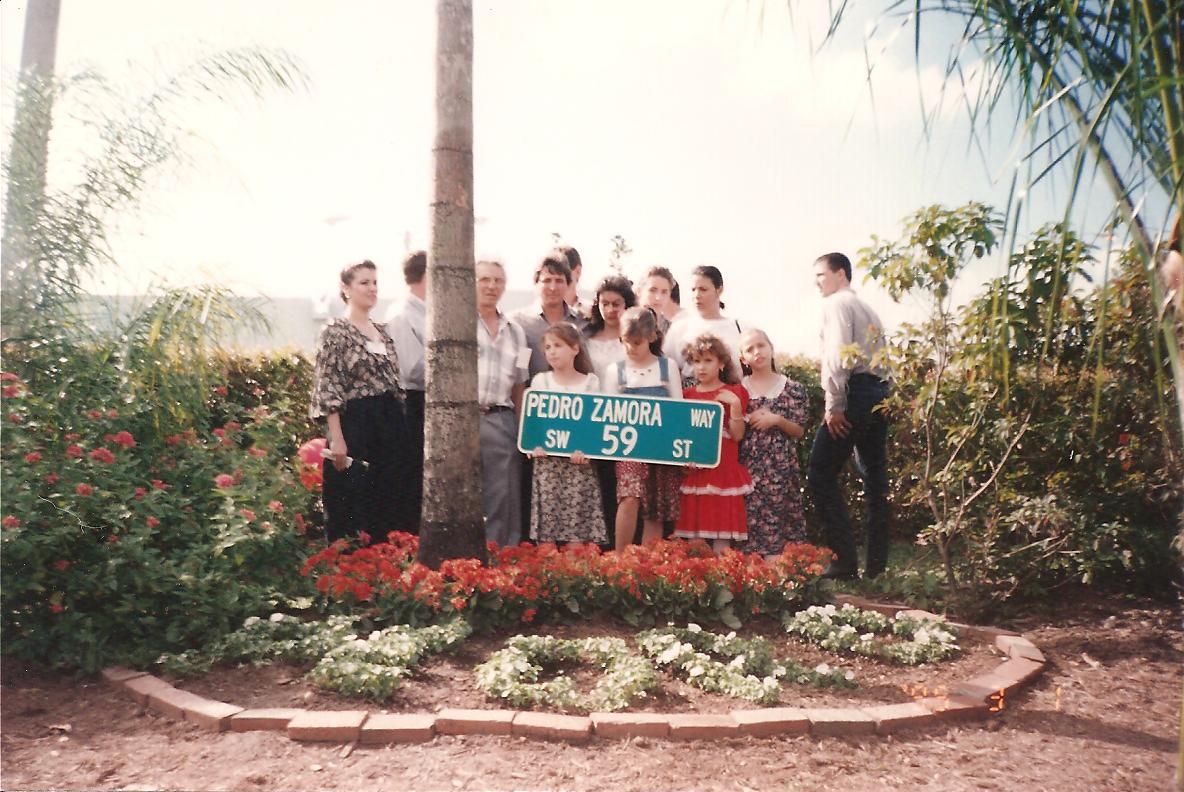 1995 memorial for openly-gay Cuban exile and AIDS educator Pedro Zamora. Between 1965 and 1968 the Cuban government interned LGBT people in labor camps called the Military Units to Aid Production. Outside the camps, discrimination against LGBT people was rampant in Cuban society, homosexuality would not be decriminalized until 1979. Queer Cubans notably tried to escape the island either by enlisting in the Cuban military to be deployed abroad, or by emigrating in the Mariel boatlift where LGBT Cuban prisoners were specifically targeted by authorities to be given approval to emigrate.[25] The male exiles of the Mariel boatlift were depicted by the Castro administration as effeminate and often implied they were gay.[citation needed] Revolutionary masculinity and an association of homosexuality with capitalism had fostered homophobic sentiments in Revolutionary Cuban culture. This atmosphere had driven many LGBTQ-identifying Cubans to flee when Castro announced he would allow the exodus. By 1980, homosexuality was no longer criminalized by Cuban law, but gays and lesbians still faced systemic discrimination. There was a social phenomenon of men pretending to be gay to pass the interviews required of applicants for the exodus, because it was believed that homosexuals were more likely to pass the panel held to determine if a person could exit from Cuba. Communities of gay exiles formed in the processing centers that formed for those applying for entry to the United States. These centers kept their gender populations segregated. As a result, a majority of reports of queer Cuban Exile communities in these centers were focused on gay male exiles. However, secondhand reports suggested parallel lesbian communities had formed in the women's population. Though United States law technically barred emigration into the country on grounds of homosexuality, exceptions were made for the exiles to support them as anti-communists. Only LGBTQ people who clearly and explicitly told the US immigration panel that they identified as such were denied entry to the United States.[26] Author Susana Pena has written about LGBT people in the Mariel boatlift and has speculated that their resettlement in Miami may have spurred on a revival of LGBT social life in Miami's South Beach.[27] Afro-Cuban Exiles Though the early waves of Cuban exiles were majority white, Afro-Cuban exiles became more common among the Mariel Boatlift and Balseros periods. Anywhere between 20% and 40% of Marielitos were identified as black. Afro-Cuban exiles from Cuba experienced a transition from the more racially integrated Cuban society, and found themselves split between a majority white Cuban exile community and a distrustful African American community. A substantial portion of Afro-Cuban exiles blended more into the African American community, but some are still tied to the Cuban community.[28] |
人々 主な記事 キューバ亡命者  マイアミ、リトルハバナの青果店(1980年) 経済 キューバ人亡命者の経済的背景はさまざまであり、その多くは移住の波を反映している。初期に移住したキューバ人の多くは中流階級や上流階級の出身だった が、キューバを離れる際にはほとんど何も持ってこなかった。マイアミやアメリカ全土に小さなキューバ人コミュニティが形成され、キューバ人が経営する小さ なビジネスが立ち並んだ。フリーダム・フライトの頃には、キューバ政府が熟練労働者の移住を制限していたため、移住者の多くは中流階級かブルーカラー労働 者だった。亡命した専門家の多くはキューバ国外では無免許であり、インフォーマル経済でサービスを提供し始めた。キューバ人亡命者はまた、スペイン語のス キルを活かして、ラテンアメリカと結びついた輸出入ビジネスを開いた。1980年代までには、多くのキューバ人亡命者が経営するビジネスが繁栄し、盛んな ビジネス・コミュニティが発展する。1980年のマリエル号によるボートリフトの頃には、キューバからの新たな移住者のほとんどは経済移民であり、典型的 にはキューバ経済の厳しい見通しから逃れるために出国した人々であった[24]。 ジェンダーとセクシュアリティ  1995年、ゲイであることを公表したキューバ人亡命者でエイズ教育者のペドロ・ザモラの追悼[24]。 1965年から1968年にかけて、キューバ政府はLGBTを「生産を援助する軍隊」と呼ばれる労働キャンプに収容した。収容所以外でも、キューバ社会で はLGBTに対する差別が横行しており、同性愛が非犯罪化されるのは1979年のことである。クィアであるキューバの人々は、キューバ軍に入隊して海外に 派遣されるか、マリエル号によるボートリフトでキューバから脱出しようとした。 マリエル号漂流の男性亡命者は、カストロ政権によって女々しく描かれ、しばしば同性愛者であることを示唆された[要出典]。革命的な男らしさと同性愛と資 本主義との関連付けは、革命的なキューバ文化において同性愛嫌悪の感情を育んでいた。このような雰囲気は、カストロが国外脱出を認めると発表したとき、 LGBTQを自認する多くのキューバ人を国外に脱出させた。1980年までに、キューバの法律で同性愛は犯罪ではなくなったが、ゲイやレズビアンは依然と して制度的差別に直面していた。キューバからの出国が可能かどうかを判断するための面接では、同性愛者の方が合格しやすいと信じられていたため、出国希望 者の面接に合格するために同性愛者のふりをする男性たちが社会現象になった。同性愛者の亡命者のコミュニティは、米国への入国を申請する人々のために形成 された手続きセンターに形成された。これらのセンターでは、男女が隔離されていた。その結果、これらのセンターにおけるクィアなキューバ人亡命者のコミュ ニティに関する報告の大半は、ゲイの男性亡命者に焦点を当てたものであった。しかし、伝聞によれば、女性の集団にも並行してレズビアンのコミュニティが形 成されていたようだ。米国の法律では、同性愛を理由とするキューバへの移住は厳密には禁じられていたが、反共産主義者として亡命者を支援するために例外が 設けられた。入国を拒否されたのは、米国の入国審査委員会にはっきりとそうであると伝えたLGBTQの人々だけであった[26]。 作家のスサナ・ペナは、マリエル号漂流におけるLGBTについて書いており、彼らがマイアミに再定住したことで、マイアミのサウス・ビーチにおけるLGBTの社会生活の復活に拍車がかかったのではないかと推測している[27]。 アフロ・キューバ人亡命者 初期のキューバ人亡命者の波は白人が大半を占めていたが、マリエル・ボートリフトとバルセロスの時代には、アフロ・キューバ人亡命者がより一般的になっ た。マリエリトの20%から40%が黒人であった。キューバからのアフロ・キューバ人亡命者は、より人種的に統合されたキューバ社会からの移行を経験し、 大多数を占める白人キューバ人亡命者コミュニティと不信感を抱くアフリカ系アメリカ人コミュニティの間で分裂することになった。アフロ・キューバ系亡命者 のかなりの部分はアフリカ系アメリカ人社会に溶け込んだが、一部は依然としてキューバ人社会と結びついている[28]。 |
| Activism Agrupación Abdala In 1968, a Cuban exile activist group called Agrupación Abdala was formed by Gustavo Marin Duarte and other children of the first wave of Cuban exiles. These Cuban Americans were associated with the United States' New Left and they held beliefs that were against the communism of Cuba but also opposed to what they perceived as imperialism by the US. They produced literature that was critical of both the United States and Cuban Communism, and performed a series of activist actions to draw attention to their cause. On the 13th of March, 1971, a group of sixteen Agrupacion Abdala activists staged a protest in the United Nations Headquarters. They staged a sit-in and demanded to speak to a high-ranking official regarding prioritizing the release of political prisoners in Cuba. They were politically militant and believed to opposed Communism violence was necessary. The group struggled to keep a coherent ideology and dissolved in 1980.[29] Truth About Cuba Committee A committee of exile activists called the Truth About Cuba Committee (TACC) formed in 1961 in the United States to present an exile-led perspective of the realities of Communist Cuba. They were an example of the beginning of Cuban exile activism that focused on the portrayal of Cuban exiles as white, middle class, and anti-communist immigrants. In 1965 their president Luis V. Manrara appeared on WTHS-TV in South Florida to publicly decry a film by the National Educational Television network (NET). NET's film, Three Faces of Cuba was decried as a pro-communist and anti-American work of art that willfully misled the public to the realities of the Cuban experience. They published a 104-page analysis of the film called An Exposé of the Insidious Film "Three Faces of Cuba". The implication of the phrasing of "expose" was that the film was not just a bad work of art but was in fact seditious to the United States. The group continued to operate against what they perceived as pro-Communist Cuban misinformation until they disbanded in 1975.[30] Other political activity See also: Dialoguero 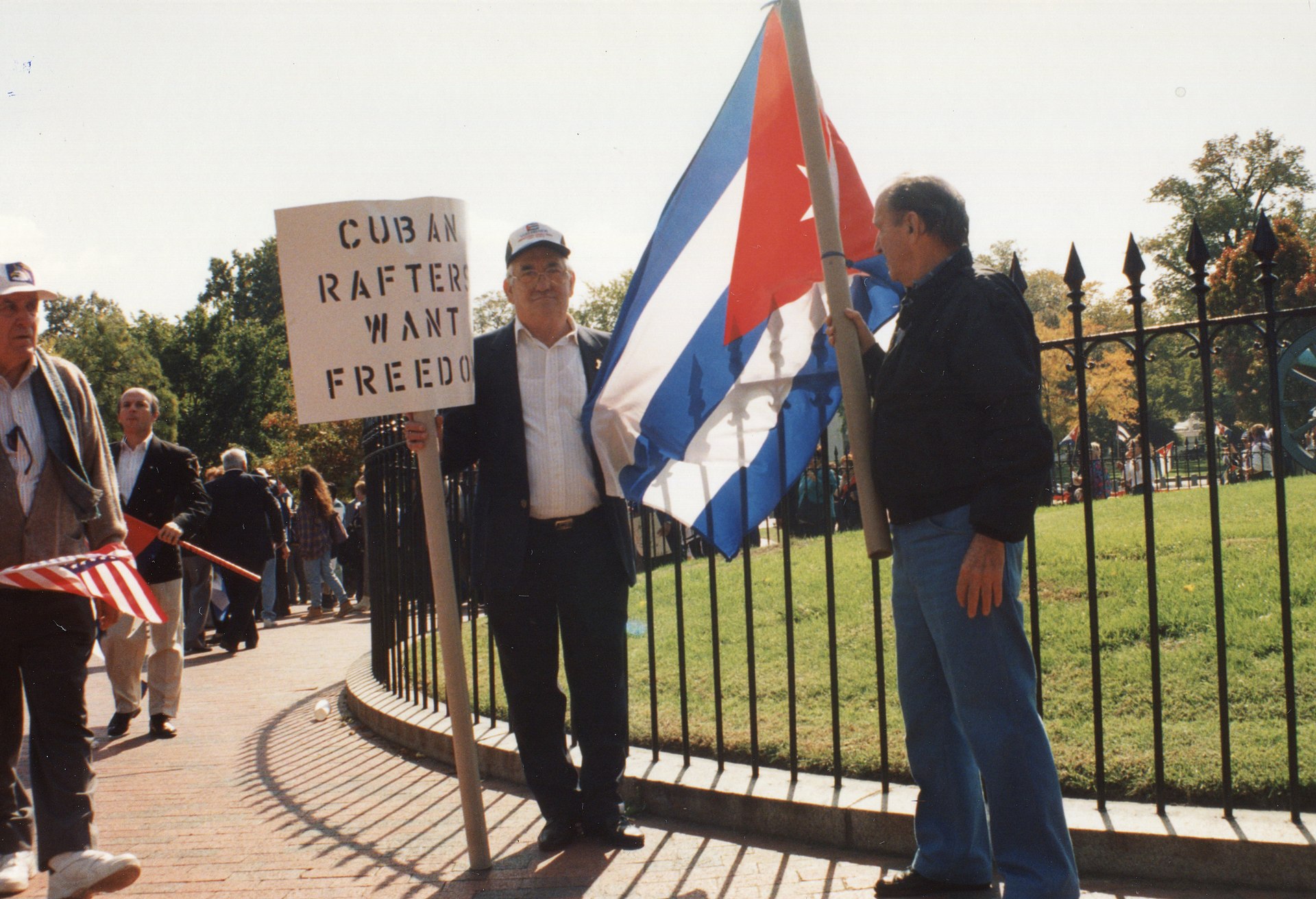 Cuban exiles protest regarding the 1994 Cuban rafter crisis. In the first years of the Cuban exile not many exiles participated in anti-Castro militancy, but many funded or supported these actions. Many exiles believed their stay abroad was temporary and that most political focus should be on the overthrow of Fidel Castro in actions such as the Bay of Pigs Invasion. As exiles continued to live abroad many began to shift their political focus to issues of assimilation. Cuban exiles would grow more politically diverse, often reflecting their social class, generation, or even participation in counter-cultural movements of the 1960s.[31] As issues of assimilation became apparent more exiles abandoned the idea that their exile would be temporary and began to seek new citizenship papers, and start voting. The terrorist activities of militant anti-Castro groups also became highly controversial in Cuban exile communities.[24] Debate within the exile community became incredibly apparent after the visit of the Antonio Maceo Brigade to Cuba and following diplomatic dialogues, many exiles became split with some supporting dialogue and travel with Cuba and others who opposed.[31] By the 1980s, Cuban exiles have formed thriving communities and began to organize powerful political organizations such as the Cuban American National Foundation. With the Special Period in Cuba political focus began on predictions of the collapse of the Cuban government and aiding internal opposition on the island. During the emigration of balseros, the exile organization Brothers to the Rescue ran humanitarian missions to save rafters as well as drop propaganda leaflets over Cuba.[24] Cuban exiles in the United States have consistently been generally more politically active and voted more conservatively than other Latino ethnic groups. In 2012, a pew research poll found over 70% of Latino voters supported Barack Obama while only 49% of Cuban-American voters supported Barack Obama. This atypical lean towards Republican candidates can be explained by the Republican Party's accusations of the communist leanings of Democratic politicians as well as Democratic politician's less hard-line stances on relations with Cuba. Despite a history of atypical conservative voting, Cuban-Americans have slowly been increasingly voting in line with the Democratic Party, partly reflecting younger generations' disinterest in relations with Cuba and the demographic differences in exiles that have arrived since the Mariel boatlift.[32] |
アクティビズム アブダラ・アグルーパシオン 1968年、グスタボ・マリン・ドゥアルテをはじめとする第一次キューバ亡命者の子供たちによって、アグルシオン・アブダラというキューバ亡命活動家グ ループが結成された。これらのキューバ系アメリカ人は、アメリカの新左翼と結びついており、キューバの共産主義に反対する信念を持っていたが、同時にアメ リカによる帝国主義にも反対していた。彼らは米国とキューバ共産主義の両方を批判する文献を作成し、自分たちの大義に注目を集めるために一連の活動家とし ての行動を行った。1971年3月13日、16人のアグリュパシオン・アブダラの活動家が国連本部で抗議行動を行った。彼らは座り込みを行い、キューバの 政治犯の釈放を優先することについて高官と話すことを要求した。彼らは政治的に過激で、共産主義に反対するには暴力が必要だと考えていた。グループは一貫 したイデオロギーを維持するのに苦労し、1980年に解散した[29]。 キューバの真実委員会 真実のキューバ委員会(TACC)と呼ばれる亡命活動家の委員会は、共産主義キューバの現実について亡命者主導の視点を提示するために1961年にアメリ カで結成された。彼らは、キューバ人亡命者を白人、中産階級、反共産主義の移民として描くことに焦点を当てたキューバ人亡命活動家の始まりの一例であっ た。1965年、彼らの会長ルイス・V・マンララは南フロリダのWTHS-TVに出演し、全米教育テレビネットワーク(NET)の映画を公に非難した。 NETの映画『キューバの3つの顔』は、親共産主義的で反米的な芸術作品であり、キューバ人の体験の現実を故意に大衆に誤解させるものだと非難した。彼ら は104ページに及ぶ『An Exposé of the Insidious Film "Three Faces of Cuba"』という映画分析を発表した。暴露する」という表現が意味するのは、この映画が単なる駄作ではなく、実際には米国に対する扇動的な作品であると いうことだった。このグループは、1975年に解散するまで、親共産主義的なキューバの誤報と認識されるものに対して活動を続けた[30]。 その他の政治活動 以下も参照: ダイアログエロ  1994年のキューバ・ラフター危機に関するキューバ亡命者の抗議行動。 キューバ亡命の最初の数年間は、反カストロ過激派に参加する亡命者は多くなかったが、多くの亡命者がこれらの行動に資金を提供したり、支援したりした。多 くの亡命者は、海外滞在は一時的なものであり、ピッグス湾侵攻のような行動でフィデル・カストロ打倒に政治的焦点を当てるべきだと考えていた。国外での生 活を続けるうちに、多くの亡命者は政治的な焦点を同化の問題に移し始めた。同化の問題が明らかになるにつれて、より多くの亡命者が、亡命は一時的なもので あるという考えを捨て、新しい市民権証を求め、投票を始めるようになった。過激な反カストログループのテロ活動もキューバ人亡命者のコミュニティで大きな 議論を呼ぶようになった[24]。アントニオ・マセオ旅団のキューバ訪問の後、亡命者コミュニティ内の議論は信じられないほど明白になり、外交対話の後、 多くの亡命者はキューバとの対話と渡航を支持する者と反対する者とに分裂した[31]。 1980年代になると、キューバ人亡命者は盛んなコミュニティを形成し、キューバ系アメリカ人国民財団のような強力な政治組織を組織し始めた。キューバの 特別期には、キューバ政府の崩壊を予測し、島内の反対勢力を支援することに政治的焦点が当てられるようになった。バルセロスの移住中、亡命者組織「救国の 兄弟たち」は、キューバ上空にプロパガンダのビラを投下するだけでなく、いかだの救助のための人道的ミッションを実行した[24]。 米国内のキューバ人亡命者は、他のラテン系民族よりも一般的に政治的に積極的で、保守的な投票を行っている。2012年、ピュー・リサーチの世論調査で は、ラテン系有権者の70%以上がバラク・オバマを支持したのに対し、キューバ系アメリカ人有権者のバラク・オバマ支持率は49%にとどまった。このよう な共和党候補への非典型的な傾倒は、共和党が民主党政治家の共産主義的傾向を非難していることや、民主党政治家がキューバとの関係においてそれほど強硬な 姿勢をとっていないことから説明できる。非定型的な保守的投票の歴史にもかかわらず、キューバ系アメリカ人は徐々に民主党に投票するようになってきてお り、これは若い世代のキューバとの関係への無関心や、マリエル号漂流以降に到着した亡命者の人口動態の違いも反映している[32]。 |
| Characteristics Various historical analysts and social critics have made analyses and generalizations of the events of the Cuban exile. Myths and pseudohistory Main articles: Cuba de ayer and Cuban success story Throughout the Cuban exodus various myths and legends arose around the history of the exodus and the nature of Cuban exiles. The main myths surrounding the Cuban exodus are the idealised vision of pre-revolutionary Cuba known as the Cuba de ayer, and the legendary financial success of Cuban exiles known as "Golden exiles", comprises the Cuban success story. The idea of the Cuba de ayer (English translation: lit. ':Cuba of yesterday') is a mythologized idyllic view of Cuba before the overthrow of the Batista government in the Cuban Revolution. This idealized vision of pre-revolutionary Cuba typically reinforces the ideas that Cuba before 1959 was an elegant, sophisticated, and largely white country that was ruined by the government of Fidel Castro. The Cuban exiles who fled after 1959 are viewed as majorly white, and had no general desire to leave Cuba but did so to flee tyranny. Cuban exiles who uphold this image of the Cuba de ayer view their version of Cuban culture as more desirable than American culture, and that it is best to recreate their lost culture of the Cuba de ayer in the United States. Proponents of the image of the Cuba de ayer also view Cuba as a more worthy country to live in than the United States and hope to return Cuba to the Cuba de ayer after the hoped for fall of the government of Fidel Castro. Critics of the idea of the Cuba de ayer claim it is a nationalist myth created for white Cuban exiles that ignores the reality of Cuban life before 1959, and embraces an exotic vision of Cuba.[33][34][35] Social researcher Jorge Duany has argued that the myth of the "Golden exiles" or the idea that most Cuban exiles are wealthy, well educated, and highly skilled unlike other immigrant populations, "does not do justice to the complex and diverse experiences" of the Cuban-American community. He states that many Cuban exiles face cultural and economic challenges resettling in the United States similar to many other American immigrant communities. He also states that as the Cuban exile progressed since 1959 more and more economically disenfranchised Cubans became part of the emigrant waves. These lower class Cuban exiles became noticeable in the Freedom Flights and especially so in the Mariel boatlift and balseros afterwards.[36] Maria Torres wrote in the Chicago Tribune that contrary to the Golden exile myth, Cubans are not entirely racially white but from various racial backgrounds and at the time the article was written in 1986, Cuban American families statistically earned less money than the average white family.[37] Cuba - United States relations Further information: Cuba–United States relations See also: Refugees as weapons According to authors John Scanlan and Gilburt Loescher, United States acceptance of Cuban emigrants after the 1959 Cuban Revolution was done in hopes they could help the United States forcibly remove the Fidel Castro government from Cuba. The acceptance of Cuban emigrants during the Freedom Flights was done in hopes of weakening the Cuban economy by draining it of workers. The United States also was generally able to paint a negative picture of Cuba by participating in the mass emigration of many who disliked Cuba and wished to flee the island. The Department of State painted Cuban emigrants in the 1960s as freedom-seeking refugees. By the Mariel boatlift the United States had lost its total aggressive foreign policy towards Cuba and instead viewed the island as a nuisance rather than a security threat. The Mariel boatlift was soon canceled after it was initiated and received little public American support. Fidel Castro benefited from the exile because he was able to remove disloyalty by directly removing disloyal citizens from Cuba.[38] The emigration of Mariel exiles set the precedent of the first homosexual immigrants being allowed into the United States, on the grounds that they were ultimately anti-communist refugees.[39] Social analyst Kelly M. Greenhill argues that the 1994 Cuban rafter crisis was in part engineered by the Cuban government to push social problems out of Cuba and threaten the creation of a humanitarian crisis for the United States. This threat would stimulate fears of Cuban immigrants in the United States as was seen previously during the Mariel boatlift and would be able to change United States policy towards Cuba in Cuba's favor,[40] |
特徴 さまざまな歴史分析家や社会批評家が、キューバ亡命の出来事を分析し、一般化してきた。 神話と偽史 主な記事 キューバのサクセスストーリー キューバからの脱出を通して、脱出の歴史やキューバ人亡命者の性質にまつわる様々な神話や伝説が生まれた。キューバ出国にまつわる主な神話は、キューバ・ デ・アイヤーとして知られる革命前のキューバの理想像と、「黄金の亡命者」として知られるキューバ人亡命者の伝説的な経済的成功で、キューバ人サクセスス トーリーを構成している。 キューバ・デ・エール(英訳:"Cuba de ayer")とは、キューバ革命でバティスタ政権が倒される以前のキューバを神話化したものである。この理想化された革命前のキューバ像は、一般的に、 1959年以前のキューバはエレガントで洗練された、大部分が白人の国であり、フィデル・カストロ政権によって滅ぼされたという考えを補強している。 1959年以降に逃亡したキューバ人亡命者は、大部分が白人であり、キューバを離れる一般的な願望はなかったが、専制政治から逃れるためにそうしたと見な される。このキューバ・デ・アヤのイメージを支持するキューバ人亡命者たちは、自分たちが作り上げたキューバ文化はアメリカ文化よりも望ましいものであ り、失われたキューバ・デ・アヤの文化をアメリカで再現することが最善であると考える。キューバ・デ・アヤールのイメージの支持者はまた、キューバをアメ リカよりも住む価値のある国として見ており、フィデル・カストロ政権の崩壊が期待された後、キューバをキューバ・デ・アヤールに戻すことを望んでいる。 キューバ・デ・アヤールという考えに対する批判者は、それはキューバの白人亡命者のためにつくられた民族主義的な神話であり、1959年以前のキューバの 生活の現実を無視し、キューバのエキゾチックなヴィジョンを受け入れていると主張している[33][34][35]。 社会研究者のホルヘ・ドゥアニーは、「黄金の亡命者」の神話、つまりほとんどのキューバ人亡命者は他の移民集団とは異なり、裕福で、高学歴で、高度な技術 を持っているという考えは、キューバ系アメリカ人コミュニティの「複雑で多様な経験を正当に評価していない」と主張している。彼は、多くのキューバ人亡命 者が、他の多くのアメリカ移民コミュニティと同様に、アメリカに再定住する際に文化的、経済的な困難に直面していると述べている。彼はまた、1959年以 来キューバ亡命が進むにつれて、より多くの経済的に権利を奪われたキューバ人が移民の波の一部になったと述べている。こうした下層階級のキューバ人亡命者 は、フリーダム・フライツで顕著になり、特にマリエル・ボートリフトとその後のバルセロスで顕著になった[36]。 マリア・トーレスは『シカゴ・トリビューン』紙に、黄金亡命神話に反して、キューバ人は完全な人種的には白人ではなく、様々な人種的背景を持っており、記 事が書かれた1986年当時、キューバ系アメリカ人の家庭は統計的に平均的な白人家庭よりも収入が少なかったと書いている[37]。 キューバとアメリカの関係 さらに詳しい情報 キューバとアメリカの関係 関連項目 武器としての難民 著者のジョン・スキャンランとギルバート・ローシャーによれば、1959年のキューバ革命後、米国がキューバ移民を受け入れたのは、彼らがフィデル・カス トロ政権をキューバから強制的に排除する手助けになることを期待してのことだった。フリーダムフライトの際のキューバ移民の受け入れは、労働者を流出させ ることでキューバ経済を弱体化させることを期待して行われた。米国はまた、キューバを嫌い、キューバからの脱出を望む多くの人々の集団移住に参加すること で、キューバを否定的に描くことができた。国務省は1960年代、キューバからの移民を自由を求める難民として描いた。マリエル号漂流によって、アメリカ はキューバに対する全面的な攻撃的外交政策を失い、代わりにキューバを安全保障上の脅威ではなく、厄介な存在と見なした。マリエル号輸送は開始後すぐに中 止され、アメリカの公的支援はほとんど得られなかった。フィデル・カストロは、不誠実な市民をキューバから直接排除することで不誠実さを取り除くことがで きたため、亡命者から利益を得た[38]。マリエル亡命者の移住は、最終的には反共難民であるという理由で、最初の同性愛移民が米国への入国を許可される という前例を作った[39]。 社会アナリストのケリー・M・グリーンヒルは、1994年のキューバ・ラフター危機は、キューバ政府が社会問題をキューバ国外に押し出し、米国に人道的危 機をもたらす脅威を与えるために仕組まれた面があると論じている。この脅威は、以前マリエル号ボートリフトの際に見られたように、アメリカにおけるキュー バ移民の恐怖心を刺激し、アメリカの対キューバ政策をキューバ有利に変えることができるだろう、と[40]。 |
| 2021–2023 Cuban migration crisis Cuba-United States relations Cuban-American lobby Opposition to Fidel Castro Cuban boat people Haitian boat people Vietnamese boat people North Korean defectors Venezuelan refugee crisis Ratlines |
2021-2023年 キューバ移民危機 キューバとアメリカの関係 キューバ系アメリカ人ロビー フィデル・カストロへの反対 キューバのボートピープル ハイチのボートピープル ベトナムのボートピープル 脱北者 ベネズエラ難民危機 ラットライン |
| https://en.wikipedia.org/wiki/Cuban_exodus |
|
| Miguel A. De La Torre. 2003. La Lucha for Cuba: Religion and Politics on the Streets of Miami. University of California Press. Pedraza, Silvia 2007 Political Disaffection in Cuba's Revolution and Exodus (Cambridge Studies in Contentious Politics)) Cambridge University Pres |
|
リ ンク
文 献
そ の他の情報
Copyleft, CC, Mitzub'ixi Quq Chi'j, 1996-2099
☆
 ☆
☆